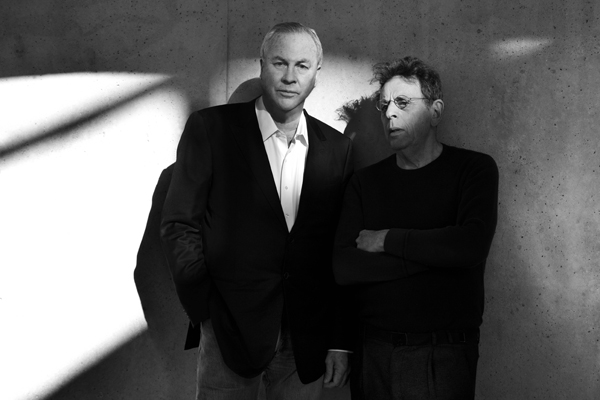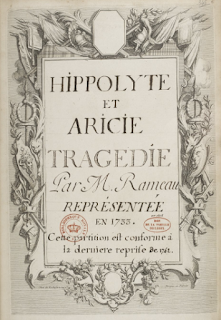Glass - Einstein on the Beach
Théâtre du Châtelet, Paris, Friday January 10 2014
Conductor: Michael Riesman. Production, set and lighting design: Robert Wilson. Costumes: Carlos Soto. Lighting: Urs Schönebaum. Sound: Kurt Munkasci. Choreography: Lucinda Childs. With: Helga Davis, Kate Moran, Antoine Silverman, The Lucinda Childs Dance Company, The Philip Glass Ensemble, Einstein on the Beach Chorus.
"The amazing thing," said a friend as we left the Théâtre du Châtelet, "is that we've sat through this for four-and-a-half hours, without an interval..." - I wondered where he was heading - "and still weren't bored shitless* like at L'Amour de Loin. Yet that was much shorter".
He was right. Einstein on the Beach is a long work and, as when you get to the end of A la recherche du temps perdu, you almost expect a reward: an "I finished Proust" or "I survived Einstein" tee-shirt. But you soon slip into the (very slow) rhythm of it, and the truth is that, though you can get up and stretch your legs if you want, few people did and we didn't.
It isn't really an opera as the term is usually understood. It's a monumental, virtuoso performance piece in nine 20-minute scenes, together making up four acts linked by small-scale "knee plays". The details are on Wikipedia, of course. It makes huge demands on the musicians, singers, dancers and, no doubt, the technical team. You wonder, for a start, how the musicians and singers keep their places in the fidgety, reiterative score, once it gets going.
There are scenes involving a steam locomotive, a boy throwing paper planes from a gantry and lots of dry ice; a courtroom with two comical judges, a jury, and stenographers who sometimes get up to scratch their bottoms; and a violinist disguised as Einstein. There are long, athletic ballets with dancers in beige harem pants and white tees whirling in front of subtly changing pastel lighting, for once (ballets often give me the impression that dancers and their choreographers are all deaf) visibly in time with the music. These go on so long and relentlessly you feel for the sweating, panting dancers. "Knee plays", sometimes with a photo of Einstein, take place in a square of white light to the right.
There's the rear end of a night train with a couple in evening dress, a slowly waxing moon and more dry ice; then that courtroom again, this time with a prison and prisoners in stripes and some virtuoso spoken text (there are lots of spoken texts) about premature air-conditioning. And then there's a magnificent scene called "Building," with the chorus - in grey trousers with braces, white shirts and basektball boots - gesticulating wide-eyed in front of a simple, painted flat of an American office building against a blue sky, in which the perspective gives an impression of great depth, while a saxophonist plays quite unexpectedly jazzy music; followed by a quite unexpectedly Zen section where a bar of white light is slowly raised from horizontal to vertical, then rises out of sight to a soprano solo with organ.
This leads into a complicated scene with the chorus beavering away busily at panels of orange lights on several levels at the rear, in some way bringing Metropolis to mind, while characters hover across or up and down in glass cases, one with a clock, the other with a compass. A pause, while a little white rocket goes up. And then, as music, movements and lights all crescendo together and a dancer flies through the air, the two principle ladies appear out of steaming bubbles in the stage floor.
Down comes a gauze with diagrams describing atom bombs. And finally, an elderly bus driver tells us a simple tale of a lovers on a park bench, holding hands in the moonlight.
Just as there are dull moments in Proust, there are moments in Einstein when your mind wanders, and it's quite obvious that some people must find it unbearable - just as I found L'Amour de Loin almost physically painful, or squirm through bad Bellini. But it took me back to something I'd almost forgotten: the exciting time at the end of the 70s and start of the 80s when "postmodernism" seemed to herald a cultural sea change and when Einstein and works it very soon influenced struck me, with something of a bang, as absolutely new and "now" and made the future seem potentially exciting, in a way that no longer seems imaginable. Experiencing Einstein today is a very useful reminder that Glass and Wilson, often now mocked, somehow caught or perhaps even helped create the spirit of that time in this monstrous masterwork. With hindsight hugely influential, it quite obviously fed into and shaped at least part of the culture of the 80s and beyond, even to the present day. Look at the current success of Daft Punk, listen to some of the music in TV commercials.
In that sense, last night I had the thrill of witnessing a historical masterpiece, flawed or not, as historical masterpieces may be, and, as Einstein is rarely staged, feeling privileged to have been there and earned my tee-shirt.
This staging is, amazingly, available for the next few months on France Télévision's CultureBox site.
*"On ne s'est pas fait chier".
Conductor: Michael Riesman. Production, set and lighting design: Robert Wilson. Costumes: Carlos Soto. Lighting: Urs Schönebaum. Sound: Kurt Munkasci. Choreography: Lucinda Childs. With: Helga Davis, Kate Moran, Antoine Silverman, The Lucinda Childs Dance Company, The Philip Glass Ensemble, Einstein on the Beach Chorus.
"The amazing thing," said a friend as we left the Théâtre du Châtelet, "is that we've sat through this for four-and-a-half hours, without an interval..." - I wondered where he was heading - "and still weren't bored shitless* like at L'Amour de Loin. Yet that was much shorter".
 |
| Glass and Wilson |
It isn't really an opera as the term is usually understood. It's a monumental, virtuoso performance piece in nine 20-minute scenes, together making up four acts linked by small-scale "knee plays". The details are on Wikipedia, of course. It makes huge demands on the musicians, singers, dancers and, no doubt, the technical team. You wonder, for a start, how the musicians and singers keep their places in the fidgety, reiterative score, once it gets going.
There are scenes involving a steam locomotive, a boy throwing paper planes from a gantry and lots of dry ice; a courtroom with two comical judges, a jury, and stenographers who sometimes get up to scratch their bottoms; and a violinist disguised as Einstein. There are long, athletic ballets with dancers in beige harem pants and white tees whirling in front of subtly changing pastel lighting, for once (ballets often give me the impression that dancers and their choreographers are all deaf) visibly in time with the music. These go on so long and relentlessly you feel for the sweating, panting dancers. "Knee plays", sometimes with a photo of Einstein, take place in a square of white light to the right.
There's the rear end of a night train with a couple in evening dress, a slowly waxing moon and more dry ice; then that courtroom again, this time with a prison and prisoners in stripes and some virtuoso spoken text (there are lots of spoken texts) about premature air-conditioning. And then there's a magnificent scene called "Building," with the chorus - in grey trousers with braces, white shirts and basektball boots - gesticulating wide-eyed in front of a simple, painted flat of an American office building against a blue sky, in which the perspective gives an impression of great depth, while a saxophonist plays quite unexpectedly jazzy music; followed by a quite unexpectedly Zen section where a bar of white light is slowly raised from horizontal to vertical, then rises out of sight to a soprano solo with organ.
This leads into a complicated scene with the chorus beavering away busily at panels of orange lights on several levels at the rear, in some way bringing Metropolis to mind, while characters hover across or up and down in glass cases, one with a clock, the other with a compass. A pause, while a little white rocket goes up. And then, as music, movements and lights all crescendo together and a dancer flies through the air, the two principle ladies appear out of steaming bubbles in the stage floor.
Down comes a gauze with diagrams describing atom bombs. And finally, an elderly bus driver tells us a simple tale of a lovers on a park bench, holding hands in the moonlight.
 |
| Wilson and Glass |
In that sense, last night I had the thrill of witnessing a historical masterpiece, flawed or not, as historical masterpieces may be, and, as Einstein is rarely staged, feeling privileged to have been there and earned my tee-shirt.
This staging is, amazingly, available for the next few months on France Télévision's CultureBox site.
*"On ne s'est pas fait chier".




Comments
Post a Comment